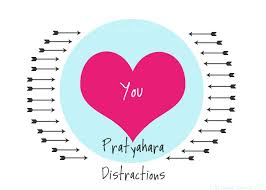The fifth limb of yoga is called pratyahara and is defined as “the conscious withdrawal of energy from the senses.” Almost without exception yoga students are puzzled by this limb. We seem to inherently understand the basic ethical teachings like satya (the practice of truthfulness), and the basic physical teachings like asana (the practice of posture), and pranayama (the use of breath to affect the mind). But for most of us the practice of pratyahara remains elusive.
Since the time of our birth, we are drawn to the external world. From the moment we exit our mother’s womb and take our first breath, the outer world calls us to explore it. Our five senses help us learn and understand the world we live in. Today, technology sucks us in and we find ourselves constantly checking our phones for text messages, emails and social media updates. But part of our yoga journey is to control what goes from our outer world to the inner world.
The fifth limb of yoga, pratyahara, comes from two Sanskrit words, prati meaning “against” or “away” and ahara, which means “food.” In this case, we can refer to ahara as any stimuli we take in and ingest. The essence of pratyahara is “withdrawal of the senses” or mindfully filtering what we experience in our outer world.
In Savasana and meditation, we can experience a deeper state of relaxation when we move through the koshas/sheaths. These sheaths can be thought of as increasingly subtle layers of consciousness. As we move through the koshas, the withdrawal is the experience of pratyahara. When you are there, you feel like you are floating and nothing can bother or irritate you. You register the sounds that occur around you, for example, but these sounds do not create disturbance in your body or mind. It is the state of nonreaction. You still register input from your sense organs, but you don’t react to that input. There seems to be a space between the sensory stimulus and your response. Or, in everyday language, you are in the world but not of it.
You can practice pratyahara whenever you notice you want to escape from your current situation. When you decide to spend hours in front of the TV, scroll on Facebook, take a trip to your favorite store, or sit and mindlessly eat – you are attempting to withdraw from your life. Instead of withdrawing from life, you can use pratyahara as a powerful tool to improve your daily life. You will see, hear, and feel the disturbances around you…and not react.

Tips to help you practice pratyahara in your everyday life:
- The sense of sight: Start by keeping the TV off whenever possible. Don’t read news stories with violent images or content. Reduce the number of ads you view in a day. Buy yourself flowers and place them in a space you are in often. Remove clutter and things that no longer serve you.
- The sense of hearing: Eliminate music with harsh, hateful, or violent lyrics. Turn off radio stories that are disturbing. If a family member or friends start to talk with negativity, tell him or her that you choose to talk about a more positive topic or quickly find a solution instead of ruminating on the problem. If you hear about a tragedy or someone in need, opt to say a prayer for the person or situation or send money to a cause that could remedy the problem.
- The sense of touch: Take time to pet your pet. Hug your family members and friends often. Allow the sun to penetrate your skin. Walk barefoot in the grass, sand, or a body of water.
- The sense of taste: Eliminate all unnatural or artificial foods from your diet. Opt for fresh fruit, vegetables, and whole grains. Eat some meals in silence and close your eyes while you taste your food to get the full sensation.
- The sense of smell: Diffuse aromatherapy essential oils or candles that makes you feel relaxed. Find a smell from childhood that brings back good memories and include that into your environment.
In a world of information overload, the yoga practice of pratyahara offers us a haven of silence.

